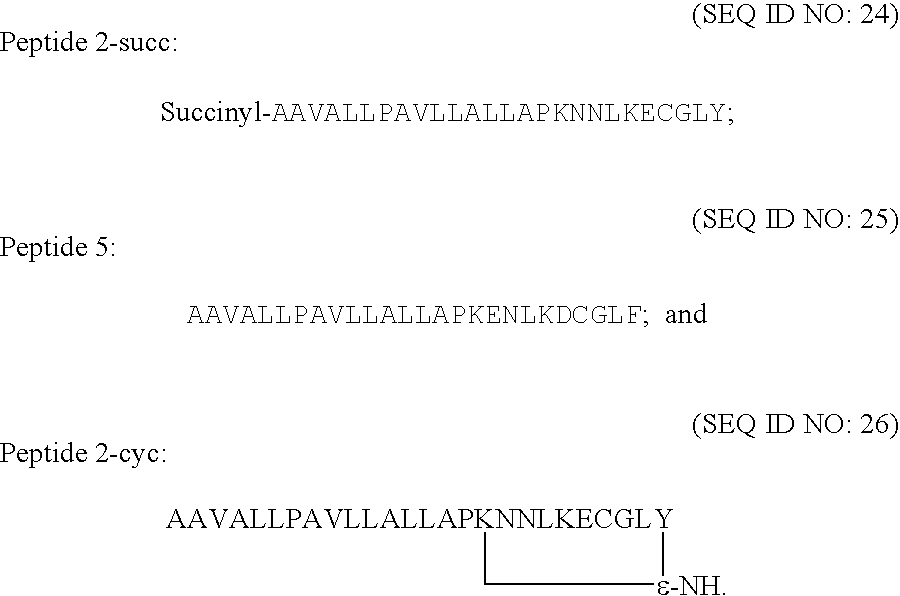Anti-allergic complex molecules
a complex molecule and anti-allergic technology, applied in the field of new drugs, can solve the problems of disodium cromoglycate not being able to inhibit all types of histamine secretion, anti-histamines cannot counteract the inflammatory reactions effected, and anti-histamines cannot provide a reliable protection against allergies
- Summary
- Abstract
- Description
- Claims
- Application Information
AI Technical Summary
Benefits of technology
Problems solved by technology
Method used
Image
Examples
example 1
[0126]Testing of Peptides in vitro
[0127]Peptides of the present invention, as described above, were tested in vitro for their ability to block histamine secretion from mast cells. Rat peritoneal mast cells were chosen as the experimental model, since it was previously shown that both rat peritoneal and human skin mast cells release histamine in response to substance P by an IgE-independent mechanism (Devillier et al., 1986; Foreman 1987a,b; Columbo et al., 1996). It was also demonstrated that the same peptidergic pathway is involved in both rat peritoneal and human cutaneous mast cells (Mousli et al., 1994; Emadi-Khiav et al., 1995).
[0128]Compound 48 / 80 was chosen as the allergen since it is one of the polycationic compounds, collectively known as the basic secretagogues of mast cells. Compound 48 / 80 has been shown to induce degranulation of human mast cells. In particular, it is very active on skin mast cells. Compound 48 / 80 has been used as a diagnostic agent in vivo to assess the...
example 2
[0139]Peptide Modifications
[0140]Results disclosed previously (International Patent Application serial no. WO 00 / 78346) have demonstrated the ability of several peptides to block mast cell degranulation. For example, a novel peptide, that was designed and synthesized to include an importation competent signal peptide, as a first segment at the N-terminus (underlined), and the C-terminal sequence of Gαi3 as a second segment at the C-terminus (AAVALLPAVLLALLAPKNNLKECGLY (SEQ ID NO:29)) inhibited histamine release from activated mast cells.
[0141]The present invention is based on results of structure activity relationship studies using several novel peptides, in which point mutations or chemical modifications were introduced. These novel peptides were designed and tested to achieve the following aims:
[0142]Aim I: To improve biological efficacy.
[0143]Aim II: To increase peptide stability and / or solubility.
[0144]Aim III: To define amino acid residues which are essential for activity and t...
example 3
[0235]Testing the Effects of the Treatment of the Present Invention in vivo
[0236]The ability of peptides according to the present invention to block allergic reaction in vivo was tested on the skin of rats by using compound 48 / 80 as the allergen. Peptides WALL007, WALL008, WALL012, WALL013, WALL014, WALL015 and WALL016 that were demonstrated to be effective in vitro, are shown to effectively block the allergic response in vivo.[0237]WALL007: AAVALLPAVLLALLAPKNNLKEVGLY (SEQ ID NO:12)[0238]WALL008: Succinyl-AAVALLPAVLLALLA-Sar-KNNLKECGLY (SEQ ID NO:13)[0239]WALL012: Succinyl-AAVALLPAVLLALLAPKENLKECGLY (SEQ ID NO:17)[0240]WALL013: Succinyl-AAVALLPAVLLALLAPKANLKECGLY (SEQ ID NO:18)[0241]WALL014: Succinyl-AAVALLPAVLLALLAP KNNLKECGL-para-amino-F (SEQ ID NO:18)[0242]WALL015: Succinyl-AAVALLPAVLLALLAPKQNLKECGLY (SEQ ID NO:20)[0243]WALL016: Succinyl-AAVALLPAVLLALLAPKNNLKEVGLY (SEQ ID NO:21)
[0244]The experimental method is described below.
[0245]Materials and Methods
[0246]The hair of the abdom...
PUM
| Property | Measurement | Unit |
|---|---|---|
| pH | aaaaa | aaaaa |
| concentrations | aaaaa | aaaaa |
| volume | aaaaa | aaaaa |
Abstract
Description
Claims
Application Information
 Login to View More
Login to View More - R&D
- Intellectual Property
- Life Sciences
- Materials
- Tech Scout
- Unparalleled Data Quality
- Higher Quality Content
- 60% Fewer Hallucinations
Browse by: Latest US Patents, China's latest patents, Technical Efficacy Thesaurus, Application Domain, Technology Topic, Popular Technical Reports.
© 2025 PatSnap. All rights reserved.Legal|Privacy policy|Modern Slavery Act Transparency Statement|Sitemap|About US| Contact US: help@patsnap.com



